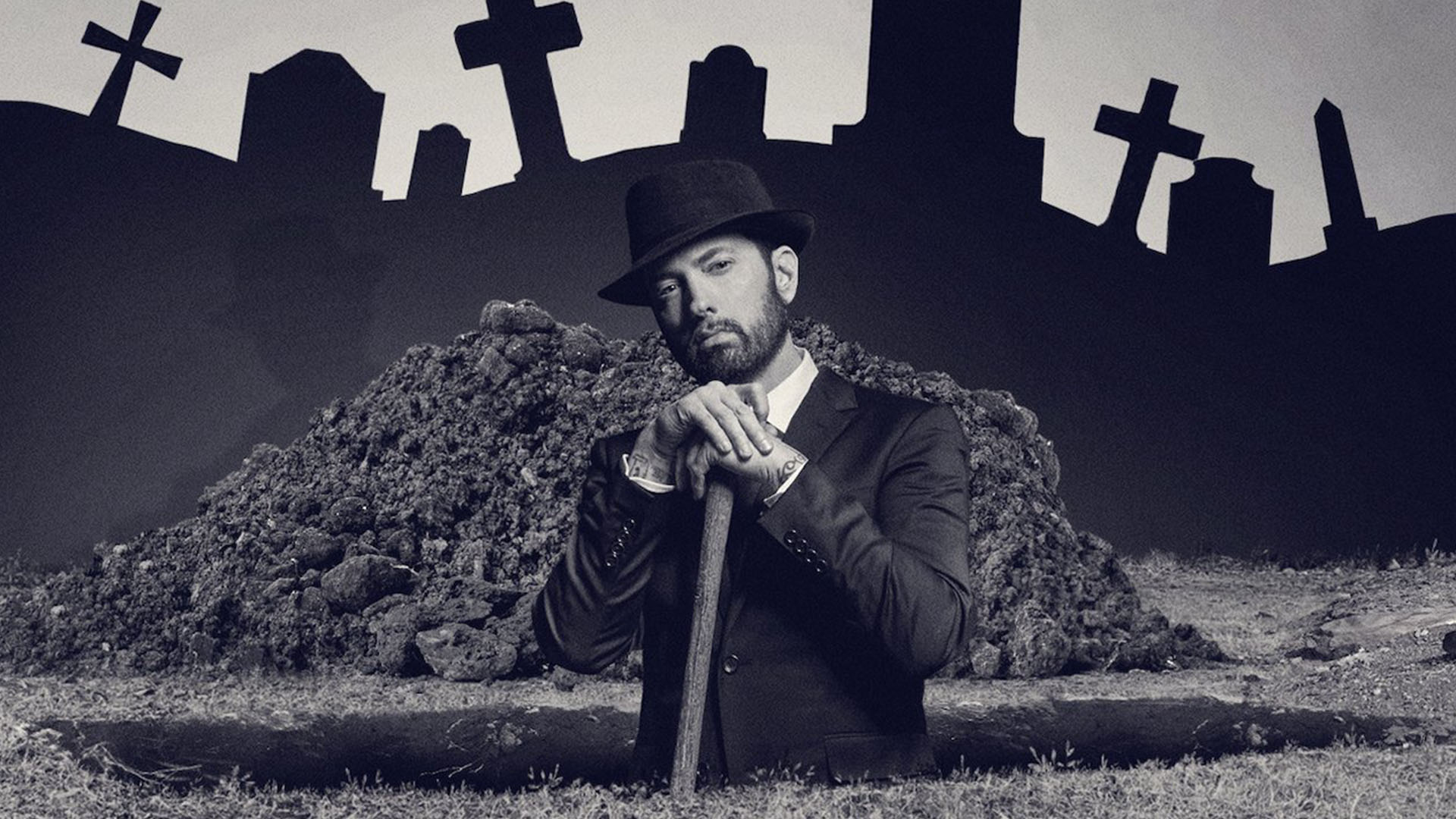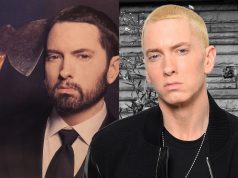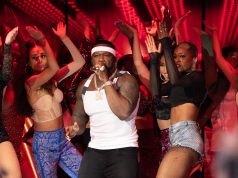The magazine compiled the list of the best rappers for each year since 1979, and Eminem appears on it twice, alongside 50 Cent.
The list called The Best Rapper Alive, Every Year Since 1979 starts with Grandmaster Caz and goes through Marshall’s childhood idols like Kool Moe Dee, LL Cool J, KRS-One, Rakim, Big Daddy Kane etc. until it comes to 2000 that the magazine dedicates to Marshall’s breakthrough,
2000: EMINEM
CREDENTIALS: The Marshall Mathers LP, guest spots on “Forgot About Dre” and “Don’t Approach Me,” three classic singles with “Real Slim Shady,” “The Way I Am,” and “Stan,” becomes most controversial rapper on the planet.
After the immense success of The Slim Shady LP and Dr. Dre’s 2001, Eminem was riding high even as he became overwhelmed by the reach of his new found fame. Rather than crack under the pressure, Marshall took some time (and drugs) in Amsterdam, came back Stateside, and released his magnum opus, The Marshall Mathers LP. Even if it hadn’t become one of the best-selling rap records ever, the record was still a conceptual masterpiece—with Eminem mixing autobiographical detail and absurdist fantasy to chilling results.
As Em stepped into his prime, he began demolishing verses with an unparalleled tenacity for wordplay: “Sick sick dreams of picnic scenes/Two kids, 16 with M-16’s and 10 clips each/And them shits reach through six kids each/And Slim gets blamed in Bill Clint’s speech to fix these streets?” The detail was vivid and visceral. “And if it’s not a rapper that I make it as/I’ma be a fucking rapist in a Jason mask!” His music hit a nerve on critical, commercial, and cultural levels, aided by his blonde hair and blue eyes (as he’d soon point out), but an undeniable achievement nonetheless.
Singles like “Way I Am” showed Eminem for what he was. An angry white male? Sure. But also the only rapper who could score a massive pop hit by following the words of The 18th Letter. By 2000, white boy or no white boy, you had to give him the mic and let him recite.
The second Eminem’s released secured him another entry on the list, the fit that only a few rappers were granted.
2002: EMINEM
CREDENTIALS: The Eminem Show, 8 Mile Soundtrack, three top five hits, had the best-selling album of the year across all genres
Everything you need to know about where Eminem was in 2002 you can hear in the second verse of “Till I Collapse.” He hit the scene in 1999 and became the illest rapper to hold the cordless, so by 2002 his tremendous talent was unquestionable (“You’re real and you spit and people are feeling your shit”). So much so he realized he was living through his prime (“This is your moment, and every single minute you spend trying to hold onto it ’cause you may never get it again”) and began thinking about his place in hip-hop’s pantheon, worried he’d never get the props he felt he deserved. People tend to get caught up in the fact that Em named Redman (Reggie) ahead of Jay and Biggie in his infamous list, but really the most crucial detail is that Em lists himself last. He was as high as he’d ever get but still looking for another hit, on top but still unsatisfied.
Regardless of what ideas were floating around Em’s head, he dropped another monster album that year with The Eminem Show. The record didn’t top his previous effort creatively but still managed to be one of his more accessible albums (at least for hip-hop heads), which for once pitted his lyrics against a backdrop closer to hip-hop’s sonic center—laying bare just how many light years ahead of the average rapper he was.
Yet, that album might not have even been his greatest achievement that year. With the release of the loose biopic, 8 Mile, Slim Shady became an unlikely people’s champ, the rap Rocky. The first single to the film’s soundtrack, “Lose Yourself,” became Eminem’s biggest hit ever and one of his best songs. “Lose Yourself” encapsulated what made Em so special. It was a rap song about the physical act of rapping, proving that Eminem was and would always be a rapper’s rapper, a true student of Rakim. Yet, thanks to his songwriting skills it was also a massive pop hit and had middle Americans who would otherwise never interact with rap chanting along. There may be unwelcome side effects to that (as seen by the burgeoning number of white rappers), but Em still spread the gospel of hip-hop and did it in the most authentic way possible.
It was only a short while after this that Chris Rock would point out that the best golfer was black, the tallest basketball player was Chinese, and the best rapper was indeed white.
Eminem has also got into honourable mentions for years 1999, 2001, 2003 and 2010.
50 Cent has also got his own year on this list.
2003: 50 CENT
CREDENTIALS: Get Rich or Die Tryin’, back to back No. 1 hits with “In da Club” and “21 Questions,” guest spots on “Magic Stick,” “We All Die One Day,” and “The Realest Killaz,” and the merciless destruction of Ja Rule’s career
Only one year prior to the release of Get Rich or Die Tryin’, no one could have predicted 50’s rise. Roc-A-Fella was on top; Cam’ron was rapidly becoming one of the biggest rappers in New York, ready to succeed Jay Z on the back of massive singles “Oh Boy” and “Hey Ma.” Jay Z was coming off the most celebrated release of his career and was about to release an ambitious double album. And 50’s fellow Queens-repping street rapper Ja Rule was dominating the charts with a series of hip-hop ballads.
50’s career, meanwhile, was in stasis; labels wouldn’t touch him and thought he was a danger to himself, and more importantly to their bottom line. Columbia was wary before the shooting; songs like “Ghetto Qu’ran,” which controversially detailed the history of Queens gangsters (“Don’t be surprised/How freely I throw out names of guys who dealt with pies”) and “How to Rob,” a song-length threat to jack every rapper in the game, had already stirred up controversy. In 2000, 50 was stabbed in a conflict with rapper Ja Rule’s entourage. He was shot and survived an infamous attempt on his life that same year. Who knew what other kinds of trouble he could get into? Columbia promptly dropped him, and his debut record, Power of the Dollar, was shelved.
But the labels missed out on what made those songs resonate. As a rapper, 50 was ruthless and fearless. And more importantly, he was both of those things more convincingly than Jay Z, who had begun to make moves toward critical respectability and retirement.
And then 50 Cent began releasing mixtapes. At the beginning of June 2002 came 50 Cent Is the Future; the title was prophetic, and buzz built quickly. It became readily apparent that not only did 50 Cent have a brash street-friendly presence, but he had an ear for melodic hooks. His tapes reinvented pop music for a street audience. Meanwhile, his slurred rap style had a national appeal, which enabled his verses to fit in well with the drawled Southern rappers who had begun to break out in Houston and Atlanta.
Around the same time, a copy of 50’s Guess Who’s Back? CD—a compilation of tracks recorded during the sessions for the unreleased Power of a Dollar LP for Columbia—found its way into Eminem’s hands. Rumors that summer spread; 50 Cent was signed to Interscope for a reported $1 million. Dr. Dre would helm the project. 50 released another mixtape, No Mercy, No Fear, the title of which advertised his selling points. Here was a rapper who seemed part artist, part action hero.
Coming on a wave of hype, Get Rich or Die Tryin’ was the most anticipated rap debut since Doggystyle. Released in February 2003, the album dominated the year, becoming one of hip-hop’s best-selling albums. By the end of that year, it had gone six-times platinum. It reoriented the entire genre toward street rap’s hard edge, spawned a pair of No. 1 singles (“In da Club” and “21 Questions”), and a third that could “only” manage No. 3 (“P.I.M.P.”). It also launched the careers of his entire crew, was Grammy-nominated, and became a full-on pop culture phenomenon.
Meanwhile, his long-simmering beef with Ja Rule and Murda Inc. boiled over with the release of 50’s “Realest Killas,” which explicitly accused Ja Rule of biting 2Pac. Ja had commercial success on his side prior to ’03, but at that moment, 50 successfully got under his skin. Ja Rule released a slew of diss tracks in response, culminating in 2003’s diss album Blood in My Eye. The album was a commercial flop, relative to his previous releases; 50 Cent’s debut, meanwhile, continued to spiral upward, ultimately selling more than eight million copies.
Read the The Best Rapper Alive, Every Year Since 1979 on the magazine’s website.












